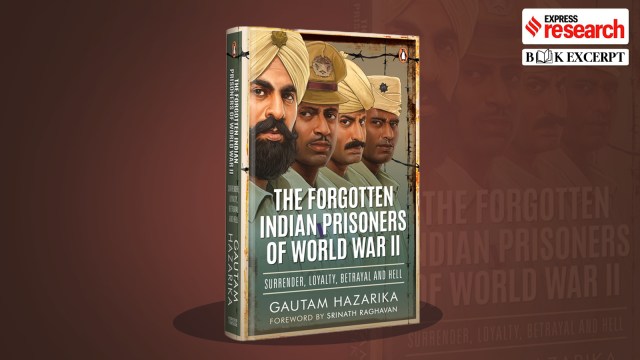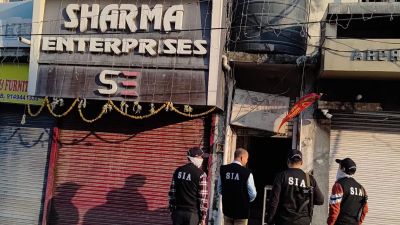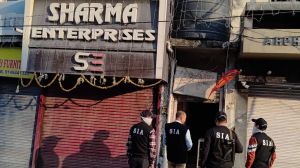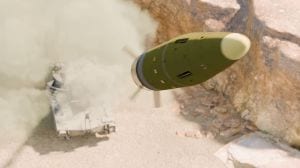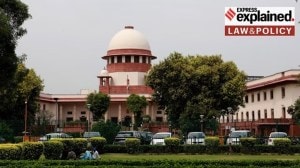On February 15, 1942, Britain surrendered Singapore to Japan. With the British defeated, Mohan Singh — a Sikh officer of the 14th Punjab Regiment—collaborated with the Japanese to establish the first Indian National Army (INA), aiming to expel the British from India.
Two days later, on February 17, 1942, at Singapore’s old racecourse in Farrer Park (near today’s Little India), Singh addressed thousands of Indian soldiers. Taking the microphone, he urged them to swear an oath to fight for India’s freedom. The crowd cheered, throwing their turbans and caps into the air. Yet, not everyone was convinced.

Of the 65,000 Indian soldiers and officers who surrendered at Farrer Park, around 20,000 chose to join the INA. The hesitation and the fate of those who did not are explored by Gautam Hazarika in his recent book The Forgotten Indian Prisoners Of World War II: Surrender, Loyalty, Betrayal and Hell (Penguin Random House India).
“Hazarika also provides an unflinching narrative of the privations endured by Indian soldiers who refused to join the INA. Some of them were deported via transit camps in Indonesia to islands in the Pacific, where they were subject to a brutal labour regime laced with torture and summary execution,” notes historian Srinath Raghavan in the book’s foreword.
The following excerpt, from Chapter 4, The Great Escape from Singapore, focuses on the few officers who were officially recognised by the British as genuine escapees from Singapore in 1942.
Pillai’s Early Attempts to Escape
Lieutenant Markandan Mairugesan Pillai of the Royal Bombay Sappers and Miners was one of those who refused to remain a prisoner and thought of escape from the very beginning. He was wiry and determined, and it showed in everything he did—when he joined the army against his family’s wishes and later when he refused to remain as a prisoner after the surrender. He waited for a chance to join the engineers, his preferred field, and the twenty-nine-year- old was commissioned on 24 February 1941. Soon, he set sail for war from Bombay on the Royal Navy heavy cruiser HMS Devonshire, which eventually took them to Singapore. During the battle in Malaya that followed, his unit spent most of its time blowing up bridges to hinder the Japanese advance, though that was not enough to stop them. They returned to Singapore on 31 January 1942, the day the causeway linking it to mainland Malaya was blown up. After a few days of being deployed in their trained role as engineers, they were thrown into fight like infantry.
When the surrender was announced on 15 February, he thought of taking a boat to Sumatra with two of his colleagues, but as they were then far from the coast, realized this was unfeasible. That night, he could not sleep, and his mind went back to some days ago when he had been cut off from his unit and wandered alone through Malaya before finding them. He had survived, as he had been able to melt into the local population, many of whom were South Indians like him, and wanted to try that again. The next morning, he mentioned this to his commanding officer, Major R. Dinwiddie, Royal Engineers, who told him that Kirkee, near Poona, Maharashtra (the home base of the Bombay Sappers), was a long way away and besides, as ordered by the Japanese, he had already submitted a list of names in his unit that included Pillai. If he escaped now, he would be missed, hunted and those who remained would pay the price as well. Despite this dampening assessment, seeing his determination, Dinwiddie gave Pillai $30 seed money that was soon to be used very effectively.
Story continues below this ad
Deterred by Sharks
Later that day, the Japanese segregated the races, with the British officers of the Indian Army being ordered to the Changi area and the Indians to Farrer Park near Little India, where thousands started gathering. As there were no Japanese guards, and hence no prison atmosphere, the determination to escape became stronger. Pillai was encouraged by Major Bhonsle, who also asked him to tell his own wife he was safe in case he happened to succeed. That night, Pillai tried his first escape. A strong swimmer, he went to the coast, from where he could see islands nearby. Though Sumatra was 60 miles away, there were about 100 islands on the way, so he estimated there would be no more than a 1- or 2-mile swim between each. Many were uninhabited but would be good resting grounds. He left his uniform on the beach and set off in his underclothes with just Dinwiddie’s $30 wrapped in the silver foil of a cigarette packet. After a quarter mile of breaststroke, he saw a splash about 150 feet away. Realizing these were shark-infested waters, he returned as quickly as he could. But he had lost his bearings and could not find the spot where he had left his clothes, so he headed stealthily back to Farrer Park and managed to rejoin his unit before dawn.
That morning, 17 February, Pillai met Major Bhonsle again, who was annoyed to see him back, and told him that now he would be unable to escape. Later that day, he witnessed the Farrer Park handover ceremony, and then moved with his unit to the Bidadari Camp. There, they soon settled down into a routine of poor food and medical facilities, overcrowding, hard labour and increasing restrictions on movement, a far cry from what was promised by the Japanese. Pillai was determined to escape. By March 1942, Sumatra had fallen to the Japanese, so heading there was not an option. Besides, the lack of boats and threat of sharks meant the sea route anywhere else was also out. The only option was the much longer trudge by land across 3000 miles of Japanese-occupied territory. But for any plan to work, he needed help from the outside. This is when he thought of contacting the only person he knew beyond the confines of the camp.
The Second Escaper: Lieutenant V. Radhakrishnan
Lieutenant V. Radhakrishnan was a thirty-four-year-old Tamilian engineer who had moved to Singapore in his twenties and started working in the Government Trade School as an instructor. His wife was from a Tamilian family in Ipoh, Malaya, and they had two children. After World War II began in Europe in 1939, he joined the Singapore Volunteer Corps, with other civilians who received military training and were called upon to fight when the need arose. In early 1941, with war clouds looming in the region, he sent his family to India. Shortly after, when Pillai was recovering from malaria after his arrival in Malaya, he happened to meet Radhakrishnan at a coffee shop in Singapore. Finding much in common, a friendship began that was to be pivotal in the escape in 1942. Though many volunteers fought alongside the military, after the surrender, the Japanese did not imprison the Indian members of the Singapore Volunteer Corps, so Radhakrishnan remained free in the bungalow in McNair Road allotted to him by his school.
Eunos the Wine Waiter
As Pillai was in a camp, he needed someone with outside access to contact Radhakrishnan. Like many other Indian POWs, his unit’s wine waiter, Eunos, planned to escape into the city, merge himself into the local population and set up his own business. So, from Dinwiddie’s $30, Pillai gave him $10 to find and ask Radhakrishnan to get in touch with him. They met in early April 1942, and he arranged for an Indian Independence League (IIL) card for Pillai, which enabled free movement in the city. However, regarding the escape, he wanted some time to think about it.
Story continues below this ad
Meanwhile, Pillai continued preparing. His men had given him two books they had found. One was On the Run, and it had stories of escape during World War I, which provided inspiration. The other was an atlas of the region that he devoured. Always fond of maps, it fascinated him. By looking at areas in the map in Malaya and India that he knew well, he was able to understand the terrain of Thailand and Burma.
He also prepared for the expected long walk back home by traversing the camp barefoot to get used to it. Soon, his feet got hardened, and he learnt to avoid the pitfall of stepping on thorns and ragged stones after accidentally doing so. Everyone who noticed him thought he was crazy. At times, Pillai himself agreed with them and realized he needed human companionship and could not do this alone. Radhakrishnan was an obvious partner.
The Third Escaper: Lieutenant Natarajan, IMS
To add to this, medical care was also key, so he started looking discreetly for an army doctor who also wanted to escape. He found Lieutenant Dr Natarajan, Indian Medical Service, also a fellow Tamilian. He was thirty-three years old, 5 feet 7 inches tall, bald, dark and clean-shaven. The eldest of eleven children from Coimbatore, he followed his father and studied medicine to become a doctor. After ten years of failure, ill health and a shortage of funds, he finally qualified. When the war began, he joined the army and was posted to Malaya. During the campaign, he was wounded in his right foot by a shell burst, which was to plague him and his mates later during the escape. Pillai met him in Bidadari Camp, and when Radhakrishnan decided to join, the three Tamilians teamed up to escape. Radhakrishnan sold his possessions, bought provisions such as cigars, butter, jam, Horlicks and milk, and the remaining $500 was to finance their escape. Natarajan was able to collect medical supplies.

